Expanding the fisheries management toolbox with population genetic eDNA methods
Efficient management of fish stock relies on biological monitoring for obtaining precise data on structure and size of populations. Fishery management commonly lacks knowledge on genetic population structures although this information is central for conservation efforts and sustainable management. Fast and cost-efficient methods for genetic analyses are needed to enable optimized management efforts, and environmental DNA (eDNA) has been suggested as an efficient approach to sample genetic material directly from environmental samples.
eDNA is commonly used to determine species presence and diversity but also hold great potential to obtain population level genetic information from water samples. In addition, recent findings suggest that eDNA concentration can provide a rapid, cost-effective indicator of abundance and/or biomass for fisheries stock assessments. However, the sensitivity of genetic methods used for analysing eDNA as well as the effect of environmental factors on eDNA concentrations need to be evaluated. The aim of this project is to evaluate if eDNA can be used to determine genetic population structure and population sizes for Atlantic salmon (Salmo salar) and brown trout (S. trutta), and we will specifically:
- investigate if different genetic techniques for identification of intraspecific genetic differences capture the same population structure,
- evaluate if eDNA can be used to determine intraspecific genetic difference with the same resolution as tissue samples and
- evaluate if eDNA quantity correlates with abundance and/or biomass measurements from electrofishing.
Evaluating and comparing the different methods helps finding the most time- and cost-efficient method for resolving population structure. In addition, the use of eDNA for monitoring genetic structure in fish populations as well as population sizes would provide less invasive sampling and increased efficiencies allowing sampling in remote areas not accessible for electrofishing.

About the project
Project period
- 2024-12-15–2028-03-15
Project Leader
Other participating researchers
- Martin Lind, Docent in Animal Ecology External link.
- Anders Nilsson, Professor of Biology, Lund University
Collaborations partners
- Lund University
Financiers
- Naturvårdsverket
- Formas


